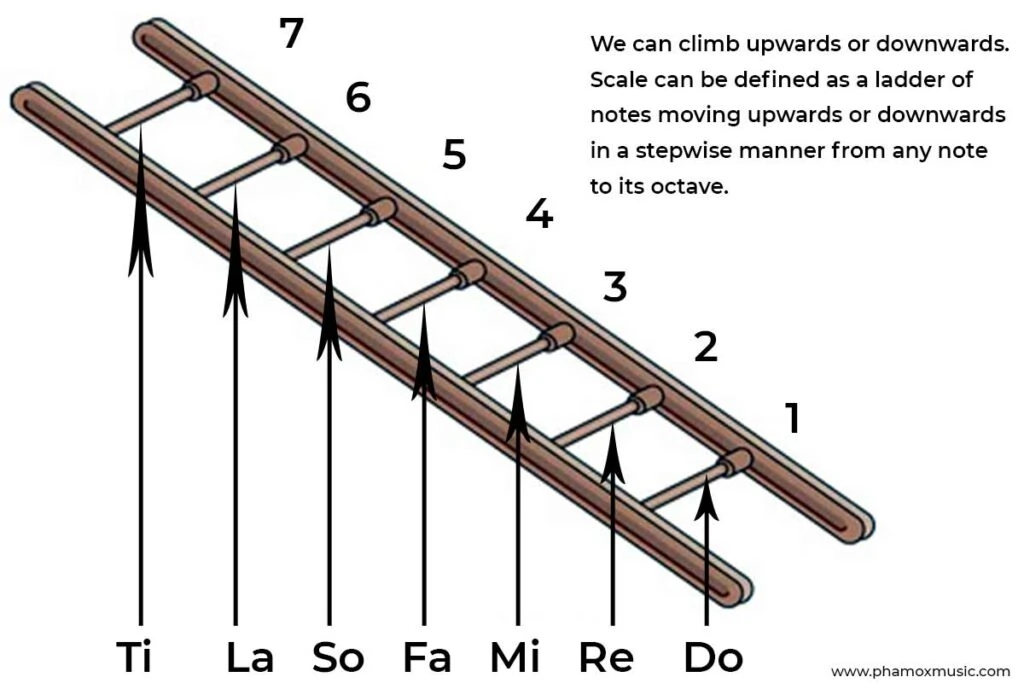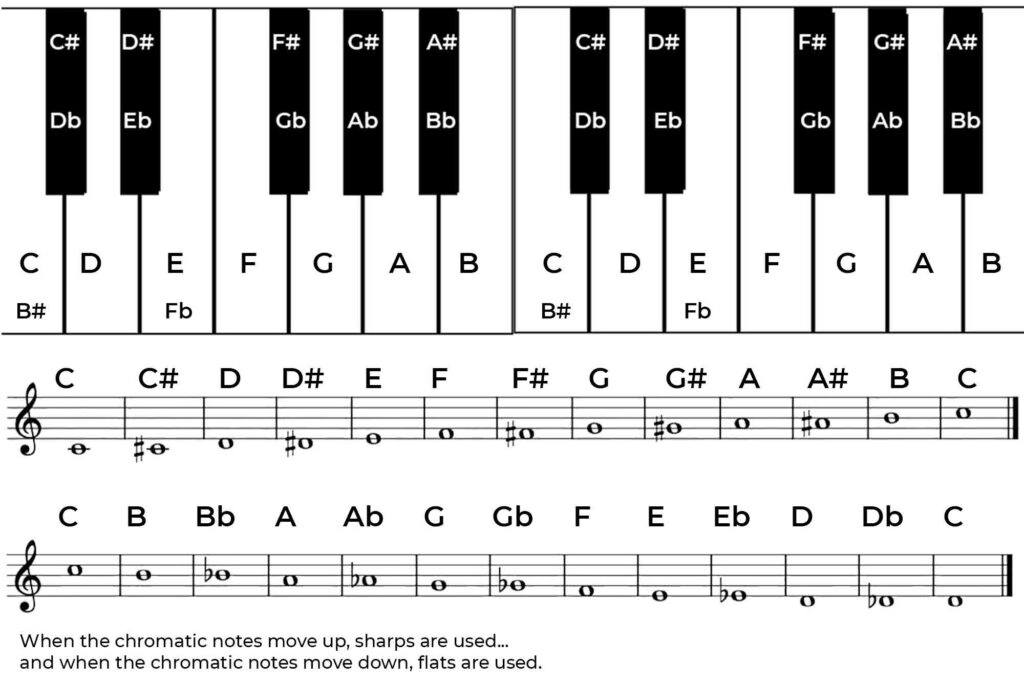The Beginner’s Guide To Scale In Music 101

Scale In Music
Scale is one of the very important aspects of music and an essential feature every student of music theory must learn and understand.
The musical scale denotes the group of musical notes used in songwriting or musical composition. And as of today, scale is one of the building blocks of music.
Of course, it plays a vital role in the meaningful performance and creation of music.
Moreover, a scale serves as a very useful tool in warmup exercises for instrumentalists as well as vocalists. That is not the major functionality of a scale in music but another way to explore it.
If you are a musical instrument student, the chance is very high that you have come across one or more types of musical scale like the major scale.
This is inevitable in the process of learning a musical instrument because most of the music is created from the scales.
Besides, knowledge of musical scales will help you to learn the instrument and new music faster and better.
Consequently, we need to learn and understand scales in music. And also know how we can use them in all our musical activities.
For that reason, in this article, we are going to learn what the scale is in music theory and how most of them are typically built.
Also, we will discuss some common types of musical scales in existence today and how they are formed.
What Is A Scale In Music?
A musical scale is a stepwise succession of musical notes going upward or downward at a defined interval from one note to the order.
This means a series of single notes progressing in an upward or downward direction with a stepwise movement.
This stepwise movement of the notes is basically in ascending or descending order of pitch as they move in an upward or downward direction respectively.
Furthermore, we can say that a scale is a group of musical notes, arranged in relation to their value of pitch at a defined interval in ascending or descending order.
When the order of notes in a scale occurs by increasing the pitch of every successive note, we have an ascending scale. That is the ascending order of pitch and means that every note is higher in pitch than the note they follow.
On the order hand, a scale with the note in successive order of decreasing in the pitch is a descending scale. Likewise, that is descending order of pitch and means every succeeding note is lower in pitch than the note they come after in order.
Musical Scale As A Ladder Of Notes

The term scale actually comes from the Latin (also Italian) word “Scala” which means a staircase or ladder.
In relation to this, we can refer to a musical scale as a “ladder of notes”. In this manner, every note of a scale is related to the steps of a ladder.
This allows moving upward or downward in a stepwise approach within the scale. This movement starts from a specific note (lower step of a ladder) and ends on the last notes of the scale.
If we take a close look at the different ladders, we would observe that each of them has steps called rung. The number of rungs varies in different ladders and this is the same in different types of musical scales.
The number of notes that make up different scales in music varies accordingly. Some have five notes while some are built with the seven-note and some twelves notes. However, all the scales in music have a defined root.
Principles Of Building A Scales In Music
A scale is a tonal cornerstone of music with a range of tones in the successive arrangements according to their pitch.
All the scales we have in music are formed differently. Some are formed with just five notes while some are formed with seven notes. There are scales with twelve notes and some do not have up to that.
Nevertheless, this aspect of music primarily has to do with the interval relationship between one note to the others.
In reality, all the scales in music have a defined root as well as their defined formula. However, the formula of the most musical scale is based on the interval relationship of tones using whole steps (tones) and half-steps (semitones).
The interval relationships that exist among different pitches of note within a scale are an essential component of a musical scale. As a matter of fact, a specific model of intervals specifies every scale in music.
So, when we link different notes together with a defined sequence of whole steps and half-steps, we create different types of musical scales.
In particular, all notes within a scale have a scale degree that defines their interval relationship and position to the root note within the scale.
Types Of Scales In Music
The scale has been part of music and is basically used to create ordered pitches. These ordered pitches are typically arranged in ascending or descending order.
Literally, most of the music we listen to and appreciate is based on one type of scale or order.
We have many scales in music with defined roots and formulas that resulted in highly distinctive sounds.
What distinguishes all these scales is the way they sound. And the way a scale will sound depends on its rule or formula.
The musical scale comes with different notes intervals built up and there are several types of musical scales in existence today.
However, most of the common types of scales in music today are made up of whole-steps and half-steps.
With the situation of building a scale, we can easily identify notes of a scale if we know the scale interval model and the root note.
Without further ado, some of the types of scales we have in music today are listed below.
- Chromatic scale.
- Diatonic scale.
- Major scale.
- Minor scale
- Pentatonic scale
- Heptatonic scale
- Phrygian dominant scale
- Hungarian minor scale
- Persian scale
- Lydian augmented scale
- Aeolian dominant scale
- Half diminished scale
- Acoustic scale
- Altered scale
All these scales are in existence but some are much more popular than the others. For instance, major and minor scales are the most common musical scale in Western music.
Consequently, we will briefly discuss some popular scales like Chromatic, Diatonic, Major, Natural Minor and Pentatonic scales in this article.
The Chromatic Scale

The chromatic scale is a musical scale that uses only half-steps for its interval relationship model. These particular scales are built with twelve tones in the tempered scale.
Actually, the total tones we have in the chromatic scale is thirteen with an additional octave in consideration.
In chromatic scale, each note is a semitone above the other in ascending movement. And semitone below each other in descending movement.
On a typical keyboard instrument like the piano, the chromatic scale uses all the white and black keys on the keyboard.
Considering the enharmonic equivalence of some notes, there are many ways we can use to represent the chromatic scale. However, the scale notation must be consecutive.
As a result, is either we stay with sharps or flat notes. Nevertheless, the chromatic scale uses sharp notes in ascending order and flat notes in descending order.
Therefore, if we start from C, we would have C-C#-D-D#-E-F-F#-G-G#-A-A#-B-C’ or C-Db-D-Eb-E-F-Gb-G-Ab-A-Bb-B-C’ in ascending and descending order respectively.
And as we have it in the diagram above, we make use of sharp notes when ascending and flats when descending.
Diatonic Scale
The diatonic scale is a musical scale with seven notes also known as the heptatonic scale. This musical scale is formed with two half steps and five whole steps within an octave.
This formation of the diatonic scale ensures the two half steps are not close to each other. To achieve this, they were separated by either two or three whole steps according to their position on the scale.
In fact, this half step positioning ensures that if the diatonic scale spans multiple octaves, all the half steps would still be separated from each other.
The diatonic scale is formed by the sequence of seven successive natural notes like we have in C-D-E-F-G-A-B.
This is purely the succession of all the white keys we have on the keyboard instrument like piano or organ
There are many other musical scales that fall under the diatonic scale and they include:
- Major scale
- Natural minor scale
- Melodic minor scale
The Major Scale In Music

The major scale is just one of several diatonic scales we have around. Specifically, the major scale is constructed with seven unique notes with an additional one known as an octave to make it eight.
The eighth or octave note is not a unique note because it is a duplicate of the first note of the scale.
The interval model for the major scale using whole steps and half steps is W-W-H-W-W-W-H. From the W-W-H-W-W-W-H model, W means whole step and H means half step.
A typical example of this is the sequence of successive natural notes starting from C on the piano keyboard. That is why playing all the white keys on the keyboard instrument like the piano is called the scale of C-Major.
All the eight notes within the major scale are in eight degrees. The technical name of each note is listed below.
1st note is Tonic (keynote)
2nd note is Supertonic
3rd note is Mediant
4th note is Subdominant
5th note is Dominant
6th note is Submediant
7th note is the Leading tone
8th note is Tonic (Octave)
The diagram above shows the sequence of notes in the key of F-Major. As we can see from the diagram, the scale contains half-steps between 3rd-4th and 7th-8th scale degrees.
The Natural Minor Scale

The natural minor scale like the major scale meets the definition of the diatonic scale. Simple because it is built with seven-notes with defined whole-steps and half steps relationships.
The natural minor scale is just a corresponding scale to the major scale. And each major scale has the natural minor scale that is corresponding to it.
This corresponding minor scale to the major scale is also referred to as a relative minor.
The Natural minor scale follows the same sequence of notes just like the corresponding major scale.
However, it begins from a different note which is the sixth-degree note of the major scale.
And from there, it continues from one note to the other until it reaches the first octave of the sixth degree.
With this build-up, the half step occurs in different sequences compared to the major scale.
The basic model of the natural minor scale is a succession of natural notes which uses all the white keys of the piano in a sequence.
Let’s say we start from the sixth degree of the C-Major scale to have A-B-C-D-E-F-G-A. This is a typical example of a natural minor scale and is known as the A-minor scale.
As a result, the new interval model for the natural minor scale using whole steps and half steps is W-H-W-W-H-W-W. From the W-H-W-W-H-W-W model, W means the whole step while H means the half step.
If we wanted to create the natural minor scale as F minor, we would start from note F. Using the W-H-W-W-H-W-W formula we would have F-G-Ab-Bb-C-Db-Eb-F‘. This scale is another example of a minor scale known as F-Minor as we have in the diagram above.
Pentatonic scale In Music

This is a musical scale with five tones (or notes) per octave. The word “Penta” basically means five so pentatonic scale means a scale with five different pitch classes.
This is unlike a heptatonic (seven notes) scale such as the major scale and minor scale or chromatic with twelves notes.
In reality, the pentatonic scale is the most popular scale around the world, maybe because they are very easy to compose.
Pentatonic scales are non-symmetrical scales. This means they do not have a unique pattern of intervals repeated within their octave.
Consequently, we have a different model of the pentatonic scale. The most common model of the pentatonic scale in Western music is a major scale model without four and seven degrees notes.
Important Of Scales In Music
Specifically, scale is very important in understanding music. Scale as said was one of the essential building blocks of music composition and it plays a vital role in the general structure of music.
The musical notes of a musical piece are chosen from the scale of the music. This is possible because the scale is a set of tones. As a result, we can create melodies and harmonies from the scale in music.
Moreover, scales are used to create chords as well as chord progression. They can even be used to establish memorable melodic ideas that go well with those chords.
In fact, the whole melodic and harmonic structure of a musical piece can generally be figured out or described in detail with respect to scales.
Scales are valid tools for complicated musical composition. In addition, it made it easy for musicians to improvise any kind of music with little effort.
Musical scales are valuable tools that enable us to understand what is going on in a piece musically. It is also a useful tool for musicians to have an insight into what they want to produce musically.
This is possible because knowledge of scales allows us to know what will happen if we do something musically in a certain way. For instance, what will happen if we play some notes over a specific chord.
As a matter of fact, knowledge of musical scale will help musicians to understand music in a deeper sense.
Final Thought
There is more revelation about scale in music and we hope this article provides you with an understanding of what scale means in music.
We have discussed some common types of scale briefly and through light on the importance of scale in music. These are the reasons every student of music should learn and understand musical scale properly.
If you are ready to have more knowledge about scales in music, start with the chromatic scale and go further from there.
At Phamox Music, we go all out for exactness and honesty. For this purpose, if by any means you found any possible glitch, be it factual, editorial or something that we need to update, kindly contact us.
If you find the information provided in this post “Scales in Music” useful and helpful, kindly share it with someone you know that might need it.






